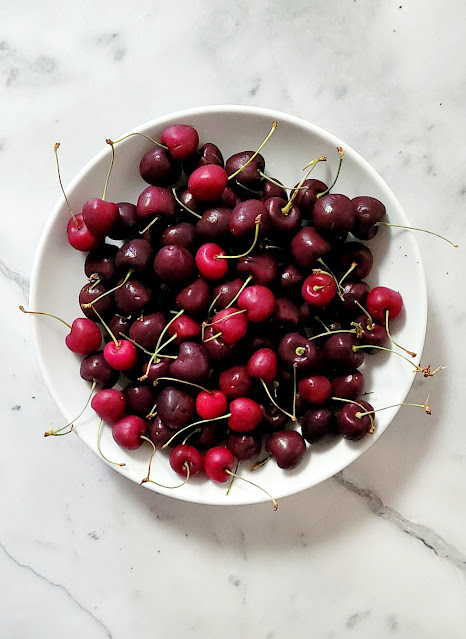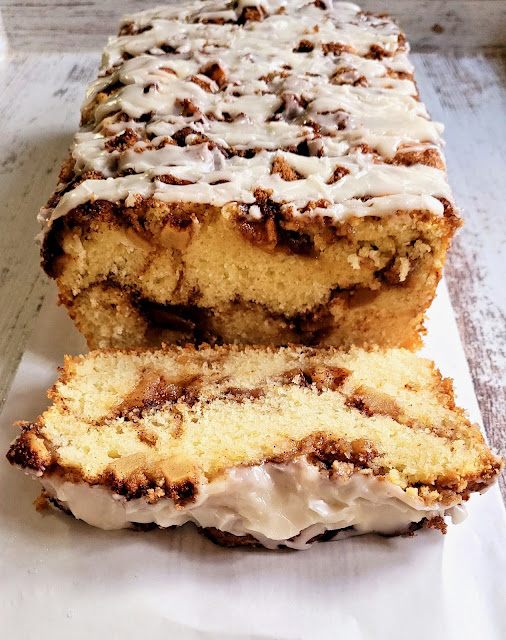Tuesday, July 15, 2025
Cherry Crisp
Tuesday, June 17, 2025
Lemon Yogurt Loaf w/ Lemon Icing
Lemon Yogurt Loaf w/ Lemon Icing
Monday, June 9, 2025
Deep Dish Rhubarb Pie
After reading Geraldine Brooks book "Memorial Days", I decided taking a trip to one of my happy places was what my grief fatigued self needed. Being near the ocean and in a beautiful familiar setting was the best way I knew how to give myself a chance to just breathe, to put all of the things I had been worrying about on a temporary pause. While this trip got off to a shaky start (a missed connecting flight and lost luggage) I arrived at my friend Sheila's cottage shortly before midnight to find a bouquet of fresh flowers, a refrigerator filled with my favorite foods, fresh eggs on the counter, two bottles of wine, and a piece of homemade rhubarb pie. I never felt so loved. As much as I wanted to immediately dive into the pie, I showed some restraint. I only waited a day. This wasn't the first piece of rhubarb pie from Sheila. Somehow I had forgotten Sheila had first given me her Rhubarb Pie recipe more than nine years ago. Which is why I asked her for it (again). It wasn't until I got home that I discovered she had made some changes to her original recipe (or the recipe I actually shared on the blog way back in 2016). The most significant changes were in the amounts of rhubarb and nutmeg.
Ingredients
Dough (Recipe for the All-Butter Pie Crust adapted from Yossy Arefi's Sweeter off the Vine: Fruit Desserts for Every Season cookbook)
2 2/3 cups all-purpose flour
1 teaspoon kosher salt
10 Tablespoons unsalted butter
8 Tablespoons ice cold water
1 Tablespoon apple cider vinegar
OR two premade pie crusts! Note: In lieu of making a homemade pie crust, recommend using a thawed boxed Whole Foods Pre-Rolled (365 Brand) Pie Crusts (found in the freezer section) or Pillsbury pie crusts found in the refrigerator section of most grocery stores. Highly, highly recommend using the Whole Foods Pie Crusts.
Pie
1 1/2 cups (300g) granulated sugar
3 Tablespoons (27g) all-purpose flour (or could use quick cooking tapioca)
2-3 teaspoons nutmeg (Sheila uses 3 teaspoons, I used a generous 2 teaspoons)
3 large eggs, lightly beaten
8 generous cups (960g) of rhubarb, cut into 1/2 inch pieces (from approximately 10 large stalks of rhubarb)
2 Tablespoons unsalted butter, cubed
Egg wash (One tablespoon of water mixed with the remaining filling adhering to the mixing bowl)
Sparkling Sugar for finishing, optional
Vanilla Ice Cream for serving
Directions
Homemade Dough
1. In a food processor, add flour and salt. Pulse several times to blend.
2. Add butter and process until coarse crumbs form, approximately 10-15 seconds.
3. Mix together ice cold water and apple cider vinegar.
4. With food processor running, slow add water/vinegar mixture in a steady stream through the feed tube. Pulse until the dough holds together. If still too crumbly, add an additional tablespoon of ice water. Dough should not be wet or sticky. Test finished dough by squeezing a small amount of dough together to see if it holds shape.
5. Divide dough in half. Shape into a disk and wrap dough in plastic wrap. Chill for at least 2 hours or overnight.
6. Roll out dough on a lightly floured surface.
Pie
1. Preheat oven to 450 degrees (F).
4. Use remaining dough to make a lattice top for the pie. Using a fork, crimp edge of pie to seal or use your fingers to create a finished edge.
5. Brush pie crust with egg wash. Sprinkle with sparkling sugar (optional). Note: To make the egg wash mix 1 Tablespoon of water with the juices left from the rhubarb mixture. Brush on the egg wash with a pastry brush.
6. Place the pie dish on a sheet pan and bake for 15 minutes at 450 degrees (F).
7. Reduce oven temperature to 350 degrees (F) and continue baking for 60-70 minutes or until juices appear thickened and rhubarb is tender. If crust is getting too browned cover with aluminum foil. Remove from oven. Allow to cool several hours before serving. Note: As pie cools to room temperature, the filling will further thicken.
8. Serve at room temperature with vanilla ice cream. (Leftover Rhubarb Pie can be covered and stored in the refrigerator. Warm cut slices in the microwave before serving or eat chilled.)
Notes: (1) You can find the link to Sheila's (first) Rhubarb Pie recipe here. (2) I let the frozen pie crusts thaw in the refrigerator overnight. (3) Use a ceramic deep pie dish for the best results. Emile Henry and Farmhouse Kitchen both made great pie dishes. (4) One cup of rhubarb weighs 120g.
Saturday, December 14, 2024
Cranberry Bliss Bars
Monday, September 9, 2024
Peach Crisp (Small Batch)



.jpg)
.jpg)


.jpg)







.jpg)






.jpg)











.jpg)




.jpg)









.jpg)
